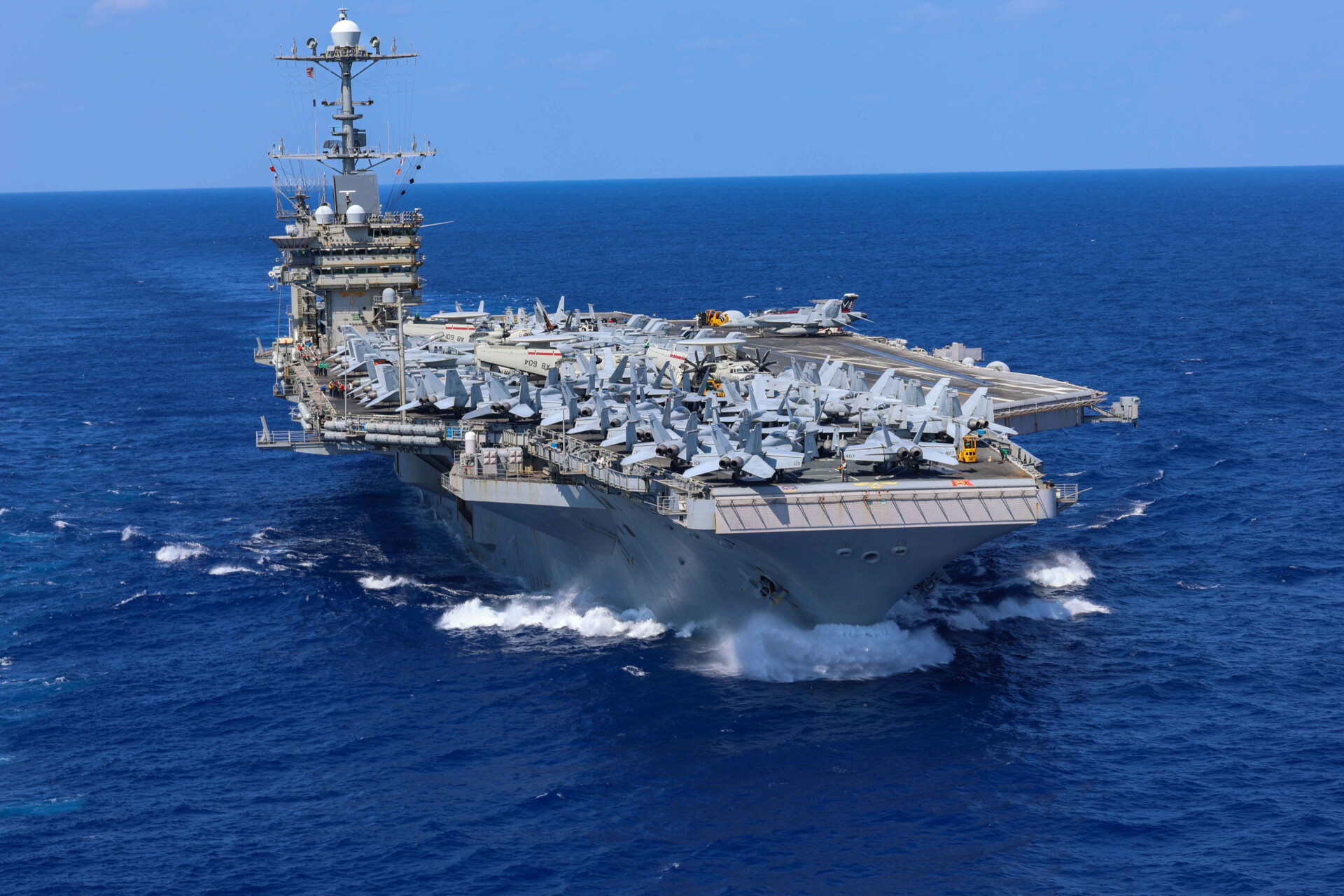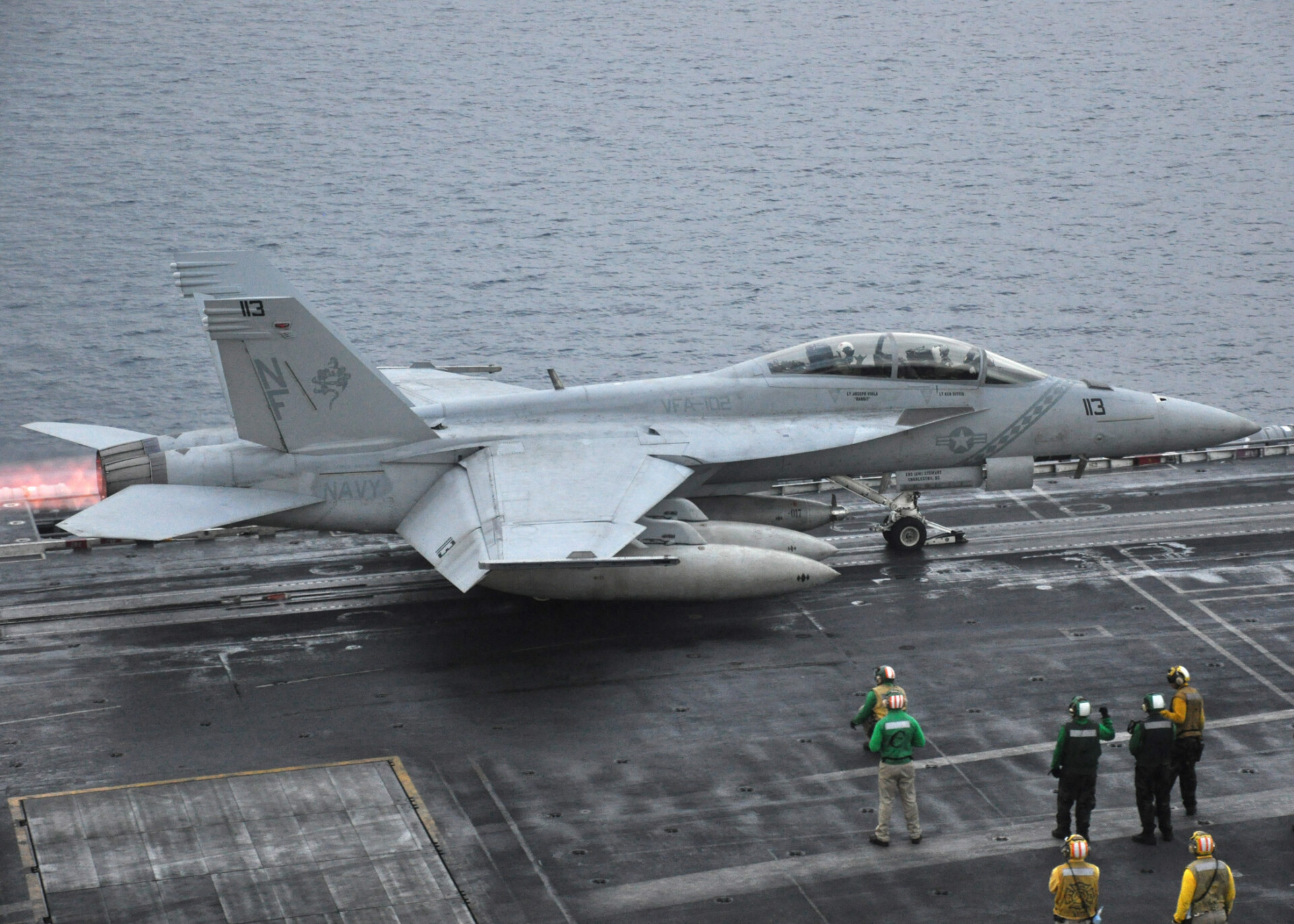Houthi Missiles Trigger Chaos: US F/A-18 Super Hornet Falls Overboard from Nuclear Carrier in Combat Zone
The incident, which underscores the mounting risk to Western naval operations in the region, occurred while the aircraft was being towed inside the hangar bay amid a high-speed turn executed by the Truman in response to a perceived missile threat from Houthi forces, known for deploying Iranian-supplied ballistic and cruise missile systems in asymmetric anti-access warfare.
(DEFENCE SECURITY ASIA) – In a stark demonstration of the intensifying military tensions in the Red Sea, the United States Navy has confirmed the loss of an F/A-18E/F Super Hornet after the multi-role combat aircraft plunged off the deck of the nuclear-powered aircraft carrier USS Harry S. Truman during an evasive maneuver aimed at avoiding an incoming missile salvo fired by Houthi rebels.
The incident, which underscores the mounting risk to Western naval operations in the region, occurred while the aircraft was being towed inside the hangar bay amid a high-speed turn executed by the Truman in response to a perceived missile threat from Houthi forces, known for deploying Iranian-supplied ballistic and cruise missile systems in asymmetric anti-access warfare.
According to a formal statement from the U.S. Navy, “The F/A-18E was actively under tow in the hangar bay when the move crew lost control of the aircraft. The aircraft and tow tractor were lost overboard.”
The Navy further added, “Sailors towing the aircraft took immediate action to move clear of the aircraft before it fell overboard. An investigation is underway,” highlighting the rapid decision-making required in high-intensity operational environments aboard forward-deployed carriers.
One sailor aboard the Truman sustained minor injuries after jumping into the water during the emergency, reflecting the human cost and physical risks tied to naval operations under wartime alert conditions.
This marks the second F/A-18E/F Super Hornet lost from the Truman within six months, following a previous incident in December 2024 when a Super Hornet was inadvertently shot down by the USS Gettysburg, a Ticonderoga-class guided missile cruiser providing layered defense coverage in the volatile maritime theatre.
Speaking to CNN, a senior U.S. Navy official confirmed that the aircraft, estimated to be worth approximately US$60 million (RM264 million), has sunk to the ocean floor, resulting in a substantial material and strategic loss for Carrier Air Wing operations.

The downed aircraft belonged to Strike Fighter Squadron 136 (VFA-136), part of the carrier air wing embarked aboard the USS Harry S. Truman, which currently serves as the centerpiece of U.S. naval power projection in the Red Sea region.
Deployed for several months, the Truman has been conducting intensified air and maritime strike operations against Yemen’s Houthi movement, which the United States and its allies accuse of threatening global shipping and targeting U.S. assets using Iranian-made drones, anti-ship ballistic missiles, and land-attack cruise missiles.
U.S. Central Command has acknowledged that precision strikes are being conducted daily against Houthi positions using a mix of assets including carrier-launched strike fighters, strategic bombers from regional bases, destroyers equipped with Tomahawk Land Attack Missiles (TLAMs), and unmanned aerial vehicles (UAVs), in an effort to neutralize launch sites and degrade the group’s long-range strike capabilities.
In light of the ongoing threat environment, Defense Secretary Pete Hegseth has already extended the Truman’s deployment by an additional month, underscoring the Pentagon’s strategic emphasis on maintaining persistent deterrence and maritime security across the Bab el-Mandeb and Red Sea shipping lanes.
The redeployment of the USS Carl Vinson, another nuclear-powered aircraft carrier, to the region further reinforces Washington’s commitment to ensuring the freedom of navigation in one of the world’s most critical maritime chokepoints amid Iranian-backed proxy escalation.
While the Navy has not released the exact details of the maneuver that caused the aircraft to fall overboard, imagery and footage on the Department of Defense’s official platforms illustrate that Nimitz-class supercarriers are engineered to perform aggressive evasive turns, resulting in significant roll angles during combat maneuvers exceeding 30 knots in speed.

Military analyst and former U.S. Navy captain Carl Schuster told CNN that such carriers, when facing missile threats, often employ “zig-zag” evasive tactics to throw off missile guidance systems.
“You typically do a series of alternating 30- to 40-degree turns. Each takes about 30 seconds each way, but the turn starts sharply. It is like riding in a zig-zagging car,” Schuster explained.
“The ship leans about 10 to 15 degrees into the turn, but it displaces the ship about 100 to 200 yards from any likely aim point,” he added, referencing the kinetic energy and lateral movement that can confuse missile trajectory predictions.
The USS Harry S. Truman (CVN-75), a Nimitz-class aircraft carrier commissioned in 1998, is one of the most powerful instruments of U.S. maritime force projection, designed to serve as a floating fortress and command hub for sustained power projection in high-threat regions.
Constructed by Newport News Shipbuilding, the vessel spans 333 meters in length and displaces over 100,000 tons fully loaded, with propulsion delivered via two A4W nuclear reactors that enable continuous deployment for over two decades without refueling, reaching speeds exceeding 30 knots.

Equipped with four steam catapults and arresting gear systems, the Truman can launch and recover over 75 fixed-wing and rotary aircraft—including the F/A-18E/F Super Hornet, EA-18G Growler, E-2D Hawkeye, and MH-60R/S Seahawk helicopters—serving as the backbone of combined air-sea combat operations.
Manned by more than 5,000 sailors and aviators, the carrier also houses advanced combat information centers, hospital-grade medical bays, and integrated logistics networks that allow it to function autonomously for extended periods while coordinating multi-domain warfare.
The ship’s layered self-defense architecture includes the RIM-116 Rolling Airframe Missile (RAM), RIM-7 Sea Sparrow, Phalanx Close-In Weapon System (CIWS), and cutting-edge AESA radar arrays, integrated with the Navy’s Cooperative Engagement Capability (CEC) network to provide real-time threat data sharing with nearby allied vessels.
As a key component of U.S. sea power doctrine, the USS Harry S. Truman has been central to coalition missions across the Mediterranean, Persian Gulf, and Indo-Pacific, embodying the U.S. Navy’s ability to conduct rapid crisis response, establish air superiority, and deter adversarial actions in contested waters.
Its current deployment in the Red Sea serves not only as a tactical deterrent against Houthi aggression but also as a broader signal of U.S. resolve in countering Iranian influence and protecting global maritime trade routes that carry nearly 12 percent of the world’s seaborne oil.
— DEFENCE SECURITY ASIA


